
The oceangoing sidewheel steamship Mary Celestia offers new insight into the desperate struggle between North and South—and faint echoes of her crew's private aspirations
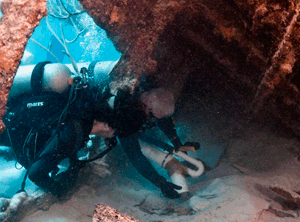
Anthropologist Philippe Rouja and archaeologist James Delgado, inside the Mary Celestia's bow, carefully fan sand into an air lift to expose artifacts buried inside.
(Tane Casserley/NOAA)
Bermuda is an island nation famous for its shipwrecks. Discovered in 1505 by Spanish mariner Juan de Bermudez, the tiny territory is made up of 181 small islands ringed by reefs that have claimed hundreds of vessels. It was a shipwreck, in fact, that led to the settlement of the islands. Today, Bermuda is home to more than 62,000 people, and some 150 to 300 wrecks are said to be submerged off its beaches and in its maze of reefs.
Several hundred yards offshore lies the Mary Celestia, an iron-hulled sidewheel steamship that hit the reef off the Gibbs Hill Lighthouse on Bermuda's southern shore on September 6, 1864. The wreck is visited each year by hundreds of divers drawn by the clear, warm waters, the coral and fish, and the skeleton of the iron steamer laid out in the coralline white sand. Although it is one of Bermuda's "top ten" diving attractions, Mary Celestia is much more than that. The wreck is an historical and archaeological site tied to one of the most fascinating naval aspects of the U.S. Civil War. It is also a site that has recently yielded new secrets thanks to a hurricane, the watchful eye of a Bermudian scientist and government official, and archaeology.
Moored over the wreck, our boat sways gently in the azure swell. As we drop into the ocean, the water is a cool 75 degrees and clear. Looking down, we see the disarticulated skeleton of Mary Celestia 57 feet below. Its most prominent features are the boilers, wedged tightly into the hull, with the tops of the engines' two cylinders between them. On one side, a 14-footdiameter paddlewheel lies facedown on the sand, while its mate remains attached to the engines on the other side. Collapsed hull plates and the tops of rusting iron frames rise like ribs out of the sand and point the way to the sharp, knifelike form of the ship's bow. The bow lies on its side, the deck angling up toward the surface. Close by the bow, the fluke of an anchor sticks out of the sand.
I am familiar with the wreck. The site was previously mapped by students working with Gordon P. Watts, Jr., from East Carolina University in 1984, and they have documented the sleek form and construction characteristics of this broken yet wellpreserved ship. Other archaeologists have visited it since then, including me. All of us have suspected that there might be more to the site. But all we had been able to excavate, so far, were a few empty wine bottles collected years ago and now displayed at the Bermuda National Trust Museum at the Globe Hotel in St. Georges.
What we know from historical records is that Mary Celestia was the product of the Liverpool shipyard of William C. Miller & Sons. Launched in February 1864 and completed two months later when its boilers and engines were installed, Mary Celestia was registered at 207 tons (the amount of cargo it was licensed to carry) and departed for Bermuda. Arriving in May, the steamer commenced the first of four known and perhaps as many as eight trips to Wilmington, North Carolina. Mary Celestia was a blockade runner.
The start of the American Civil War in April 1861 led to a prolonged four-year conflict on land and sea that neither side had envisioned. In response to the secession of the Southern states, President Abraham Lincoln quickly imposed a naval blockade of the U.S. coast from Virginia to Texas. The blockade, part of the Union's "Anaconda Plan," was designed to encircle the South and economically strangle the new Confederacy by stopping exports of Southern cotton, turpentine, and tobacco to Europe, and imports of military supplies and food. At first loosely enforced because the U.S. Navy had few ships to patrol that 3,300 mile section of coast, let alone attempt to conquer the heavily fortified entrances to Southern ports, the blockade began to tighten in 1862 as the Navy added more ships.

Delgado examines the bow of the Mary Celestia.
(Tane Casserley/NOAA)
The Southern response to the blockade was the blockade runner. These fast, sleek steamships were manned by daring captains and crews who risked coming under fire from the blockaders and faced possible capture and imprisonment, not to mention shipwreck, as they ran the gauntlet to sneak into sealed-off Southern ports. The blockade runners engaged in an illicit but highly profitable trade that saw basic commodities and luxuries sell for 200 to 700 percent more than they had in peacetime. More than fancy clothes, ladies' shoes, perfumes, and wines, however, what the government of the Confederate States of America needed were uniforms, boots, medicine, weapons, and ammunition. To prevent blockade-running companies and captains from loading their ships with high-value commodities for better profit, the Confederacy operated government-owned runners, and, in 1864, the Confederate Congress passed a law banning luxury goods on the steamers to focus the incoming cargoes on what was
needed to win the war.
Mary Celestia was one of hundreds of steamers built to run the blockade. William and James Crenshaw, two brothers from Richmond, Virginia, commissioned the ship to serve their business interests in Great Britain and its colonies, including Bermuda. They depended on regular maritime trade, running the blockade with a variety of goods and returning to Bermuda with cotton. Bermuda was the ideal transshipment point for the blockade runners. Its small port of St. Georges was crowded with ships arriving from Halifax, Liverpool, London, and Nassau carrying coal to fuel the runners. They also brought commodities that steamers could quickly run past the blockaded U.S. coast several hundred miles away. The cotton that the runners landed in Bermuda would then be sent to Great Britain in large, slow ships without fear of interception by the U.S. Navy, which stayed close to the American shore.
Mary Celestia's brief career was dramatic. Chased by a U.S. Navy blockader, the runner escaped when the captain threw 100 bales of cotton (worth some $100,000) overboard to lighten the load. The engineer then held the safety valves down to get the boilers running hot enough to push the steamer's engines to 17 knots— enough to outrun the Yankee ship.
Records also tell us that as a yellow fever epidemic ravaged the crew, the ship's North Carolina pilot—the man who knew the landmarks by which to safely navigate the hazardous approaches to Wilmington— although himself dying of the fever, stayed at his post as the runner raced past the blockaders. He brought Mary Celestia safely into North Carolina's Cape Fear River, collapsed, and died.
On its final voyage, Mary Celestia steamed out of Hamilton, Bermuda, with owner William Crenshaw and Bermuda pilot John Virgin aboard. Loaded with a Confederate government–mandated cargo of canned meat and "general merchandise" (actually munitions and Enfield rifles bound for Wilmington), Mary Celestia steamed along the southern shore of the island to drop off the owner and pilot near the Gibb's Point Lighthouse, where they both lived. As they approached the shore, according to newspaper accounts, the chief mate shouted that there were rocks ahead. The pilot, in control of the ship's movements, shouted back that he knew the reefs and rocks as well as he knew his own home. With that, Mary Celestia struck the reef. Several minutes later, as all on board scrambled into lifeboats, the steamer sank, taking with it the ship's cook, who ran back below to save something of value he had left behind, only to have a door swing shut and trap him. It had been a short life; when it sank, Mary Celestia had been afloat only two years.
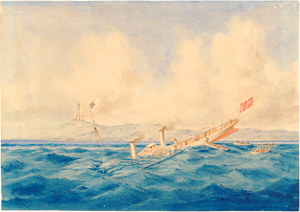
Artist Edward James depicted Mary Celestia's end in an 1864 watercolor
(Courtesy National Museum of Bermuda)
After the sinking, rumors swirled around the island that the pilot had been bought off by the U.S. Consul in Bermuda and had deliberately wrecked the ship. The Consul, Charles Maxwell Allen, wrote to his superiors in Washington that, "I am happy to say there is no evidence to substantiate their charge. The pilot has been suspended for eighteen months." Skin divers salvaged much of the cargo, probably blasting down the sides of the hull to get at the cargo holds. Then they left, leaving the iron bones of the 221-foot-long paddlewheeler to slowly fall apart over the next century and a half.
Philippe Rouja, a cultural and medical anthropologist specializing in maritime communities, has been Bermuda's Custodian of Historic Wrecks in the Department of Conservation Services since 2004. It is his job to inventory and manage Bermuda's considerable underwater cultural heritage. Post-hurricane surveys are a regular part of his routine for several significant south-shore shipwrecks. Energetic and committed to his job, the affable Rouja has been diving the Mary Celestia for more than two decades. This has given him deep knowledge of the site and the varied effects that hurricanes have had on it and Bermuda's other wrecks.
On September 5, 2003, Hurricane Fabian, a Category 3 storm, sat on Bermuda for an unprecedented 12 hours. In the aftermath of the storm, airline pilots reported seeing in the ocean large white plumes extending out from the area. Eventually a satellite photo was released by NOAA showing plumes of sand extending 26 miles from the shore, attesting to the huge volume of sand shifted off the reef platform and into the deep. When Rouja assumed his post in 2004, dive shops informed him that immediately after Fabian they had unprecedented access to the inside of Mary Celestia's bow, the only intact section remaining of the steamer's hull. They reported that sediment had been washed away, revealing intact elements of her rigging and deckcleaning materials including a brass-hooped cleaning bucket and a large demijohn.
Due to heavy weather, by the time Rouja reached the wreck, the bucket and demijohn were mere fragments of wood and glass, but two large compound rigging blocks lay in a hole just aft of the bow. Rouja consulted with the Historic Wrecks Authority, photographed these items, and then in an effort to conserve them, placed them in a mesh bag and reburied them at the site, covered by 12 heavy sandbags. Consultation with some of the older members of Bermuda's diving fraternity revealed stories that divers had found artifacts on Mary Celestia after serious hurricanes in decades past, possibly including bottles of wine and perfume from the bow.
It wasn't until Hurricane Bill in 2009 that Mary Celestia would reveal more of its secrets. On August 22, 2009, Hurricane Bill passed 80 miles off Bermuda, with 75-mileper- hour winds that knocked out power and sent massive waves crashing into the south shore. As surges washed over the reefs and around Mary Celestia, tons of sand, close to eight feet deep on the wreck and packed into the tight spaces inside the bow, were removed, along with the 12 sandbags Rouja placed there in 2006. Revealed were a single corked and still full bottle of wine, the corner of what appeared to be a wooden case, and also the entire starboard side of the stern of the ship—something Rouja had never seen in all his years of diving the site. Rouja photographed the site, retrieved the bottle of wine for analysis, and placed fresh sandbags in the bow.
The sand over the ship and in the bow remained stable through the relatively benign hurricane season of 2010, but the recovery of the bottle of wine lent veracity to the stories of other significant artifacts having been found in the bow. Rouja and the Historic Wrecks Authority began questioning whether preservation in situ was the best approach in this dynamic situation. In January 2011, in a lull between a series of significant winter storms, Rouja and a film crew from LookBermuda dove the Mary Celestia to collect footage of the wreck in the clear winter waters for a film they hoped to make on Bermuda's role in the Civil War.
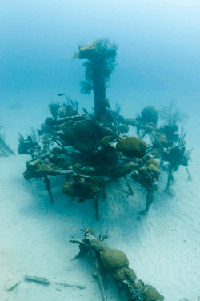
The ship's toppled starboard paddlewheel was dislodged by a century and a half of storms. (Tane Casserley/NOAA)
Mary Celestia was nearly completely covered in sand once again, the stern buried, but at the very front section of the bow it appeared that a significant amount of sand had been washed away. Inside the bow, as he peered past the deck beams and into the gloom, Rouja saw wooden planks, and in one corner, the top of a wooden crate rising out of the sand and, lying adjacent to it, another corked bottle of wine.
Under the law, Rouja can restrict access to a wreck or keep it "open." He decided to keep the popular Mary Celestia open, but with plastic mesh, cable ties, and the good will of the local dive community, he restricted access to the inside of the bow to keep curious, well-intentioned visitors from disturbing the exposed, fragile wood. He also reached out to colleagues around the world for help to assemble a team of archaeologists to excavate the bow in the face of continued erosion and the fear of loss of more artifacts.
A few months later, with the blessing of the Bermuda and U.S. governments and the support of the Waitt Institute of La Jolla, California, which funded the expedition, our team assembled off Somerset, Bermuda, to start the task of digging into Mary Celestia's bow to see what the storms had uncovered, and also what they had left behind. Rouja and I led the expedition with representatives of the Waitt Institute and NOAA as well as local volunteers. We worked for a week to excavate the forwardmost confines of the bow, an area known as the "forepeak," a tight locker where the ship's boatswain had kept his supplies of paint, tar, spare rigging, and tools.
As we hand-fanned and brushed the sand and silt into the path of our air lift so that it could be suctioned away, we gradually revealed the wellpreserved remains of the boatswain's locker, with wooden decking, paneling, shelves, and a secret stash of contraband. These brought to life the events of 147 years ago, when Mary Celestia and its crew were still running the Union blockade with illicit goods and likely making a lot of money doing so. It was also clear, as we moved deeper into the sediment, that the position of the boxes and artifacts we were uncovering offered dramatic physical proof of Mary Celestia's last moments of life as the steamer slipped beneath the waves and hit bottom.
The area we were working in is small— the bow is 28 feet long and tapers inside from 10 to two feet. After mapping and photographing the interior, we started our excavation, and soon revealed the top of the wooden crate Rouja had reburied in January. I was hopeful, as was Rouja, that we would find more than an empty box. Our hopes were realized when the outline of four bottles emerged from the sand. They were still tightly packed in their crate, which we soon realized was lying on its side, wedged against a collapsed shelf with a large oval tin basin lying atop it. Over the next week, as we cleared the site of the four feet of sand that covered an area of only six by five feet, we found more than the wine and the tin basin. A small box, its lid gone, lay on its side on the deck inside the bow. Close to it, a small bottle emerged. It was sealed with a glass stopper and filled with a clear liquid. Embossed with the legend "Piesse & Lubin, London," it was perfume from a now defunct house at No. 2 Bond Street that specialized in floral scents in the mid-nineteenth century. Other bottles had probably been inside the crate, but now it was empty. From this and the wine crate, the top of which was missing most of its planks when we found it, we saw that we were not the first to enter this area. The sea had not pulled off box and crate tops and plucked out intact bottles. Human hands had.
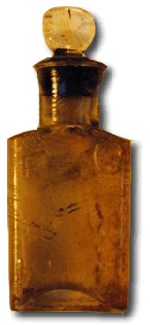
A still-sealed bottle holds an as-yet-unidentified perfume.
(Tane Casserley/NOAA)
At the forward end of the bow, wedged against a wooden bulkhead, we found another sealed wine bottle. I saw a green shape lying near it, which, as I brushed the silt away, seemed to be yet another. This one, however, was clear glass, with a narrow neck, and was filled with a yellow-green liquid and corked. It was embossed "Murray & Lanman, No. 69 Water Street, New York, FLORIDA WATER." That venerable firm, founded in 1808, remains in business, although now relocated to New Jersey. Its original 1808 formula for this citrus cologne was enjoyed in 1864 and can still be appreciated today. I know—I bought a case upon my return from the project and splash some on as a bracing aftershave, with a nice sense of history thrown in. Many of my colleagues have excavated Murray & Lanman's bottles from digs in the U.S., the Caribbean, and Australia, but no one to our knowledge has discovered a vintage sample still inside the bottle. Ours dates to no later than 1864.
The excavation also revealed a wooden hairbrush, three pairs of leather shoes, and a wooden last, the form for making a shoe. Shoemakers were a rare breed in the Confederacy, and the shoes and the last were highly valued commodities behind the blockade.
With these finds nestled in the peak of the bow, I was bemused to think that this was a secret stash of contraband hidden in the working area where the boatswain stored his spare gear and tools. We also found, among them the basin, fragments of what appeared to be paint cans with paint adhering to the corroded metal, a coil of rope, and one more amazing and exciting artifact—a spare chip log. This wooden reel with free-spinning handles was wound with a measured line and was used to determine a ship's speed. The measured line (with a small, flat wooden board attached to the end) was thrown overboard at the stern of the ship and allowed to run out as it was timed by a small sandglass. Knots were tied along the length of the line at set distances that corresponded to nautical miles. The number of knots that slipped through the boatswain's hand in 28 seconds indicated the ship's speed; to this day, we still calculate how fast a ship is going in "knots." This is, as far as we know, the first time this type of artifact has been recovered from a shipwreck excavation.
We completed our dives having excavated this part of the bow down to the well-preserved wooden deck, bulkheads, collapsed shelves, and a fallen door. The wood was intact but fragile, and as we carefully probed it, we saw that years of immersion had left it with the structural integrity of wet cardboard. There was no compelling need to recover it since we were, again, filling the area with sandbags and pumping sand back into the narrow space to seal in and preserve the wood in place. We do worry about others coming after us, especially as a series of comments by bloggers have noted that, despite the law, they have learned in Bermuda to dive alone and not tell anyone what they find. But the Mary Celestia is well-monitored and the site and the sand are deep. And Rouja is hopeful that older members of the Bermuda diving community may ultimately come forward with their finds from years past. I'm simply grateful that previous hurricanes and others' digging did not go deeper and destroy the fragile chip log or some of the other evidence. There is a special satisfaction in knowing that in this case the recovery has been fully documented both archaeologically and on film.
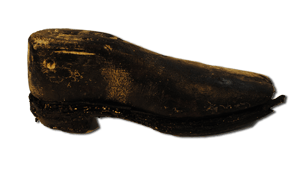
This wooden last perfectly fits a pair of leather shoes excavated with it.
(Tane Casserley/NOAA)
What do we know, other than basics of manufacture and use, about what was found stashed in the boatswain's locker of Mary Celestia? We know for sure that it was contraband, subject to seizure not only by the U.S. Navy if they captured Mary Celestia as she tried to run the blockade, but also by the Confederacy.
Who hid it in the bow? A likely suspect might be the boatswain, for this locker was his private domain on the ship. But it may also have been the cook who ran below to get something he prized as Mary Celestia sank, losing his life in the process. The amount of contraband is small. This suggests that the contents of the locker were not an "official" stash condoned by the owner or the master, but rather a private one. The wine in the crate, currently undergoing analysis, was not originally packed in it, nor apparently are the liquid contents original. The bottles were recycled, with the chipped edge of one showing it had been used more than once.
What we suspect is that a member of the crew filled twelve bottles from a barrel, packed them in a used wine crate, and stowed them along with the cologne and perfume, and perhaps the shoes, in a spot that neither the owner nor the captain would have been likely to inspect. Once in Wilmington, a handsome profit could be turned. Or perhaps the goods were not for sale, but for private use, for family members back at home.
What strikes me as an archaeologist is that the items in the bow that we excavated provide more than data. They are a tangible link to the human behaviors of Mary Celestia's crew, an intimate window into a human past often overshadowed by the big names and big events of written history. Something compellingly human, and timeless, has come to us from the long-submerged Mary Celestia.
James P. Delgado is the Director of Maritime Heritage for the National Oceanic and Atmospheric Administration's Office of National Marine Sanctuaries.
Advertisement

Advertisement







